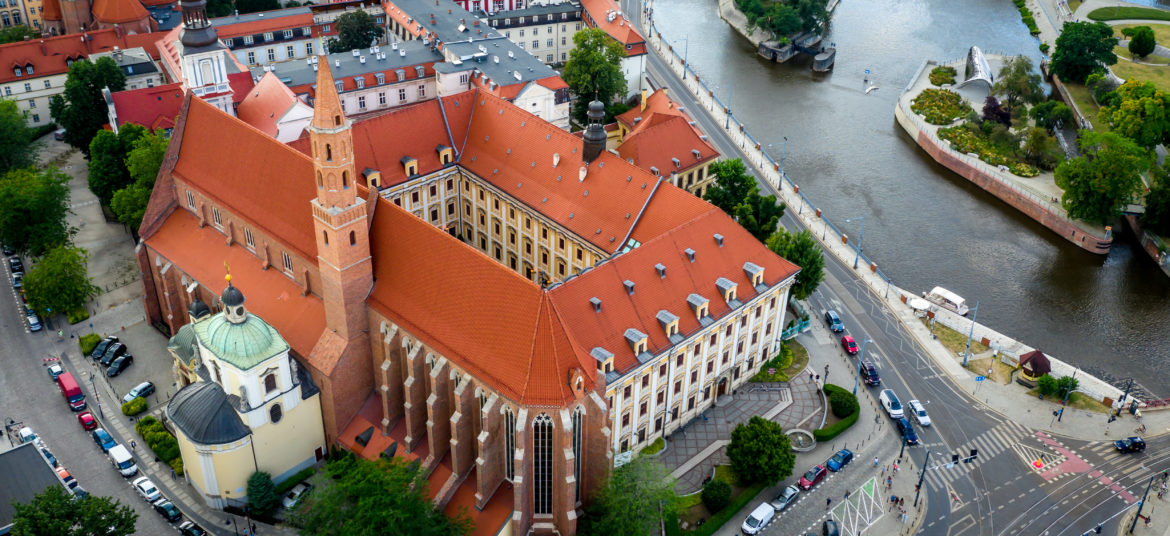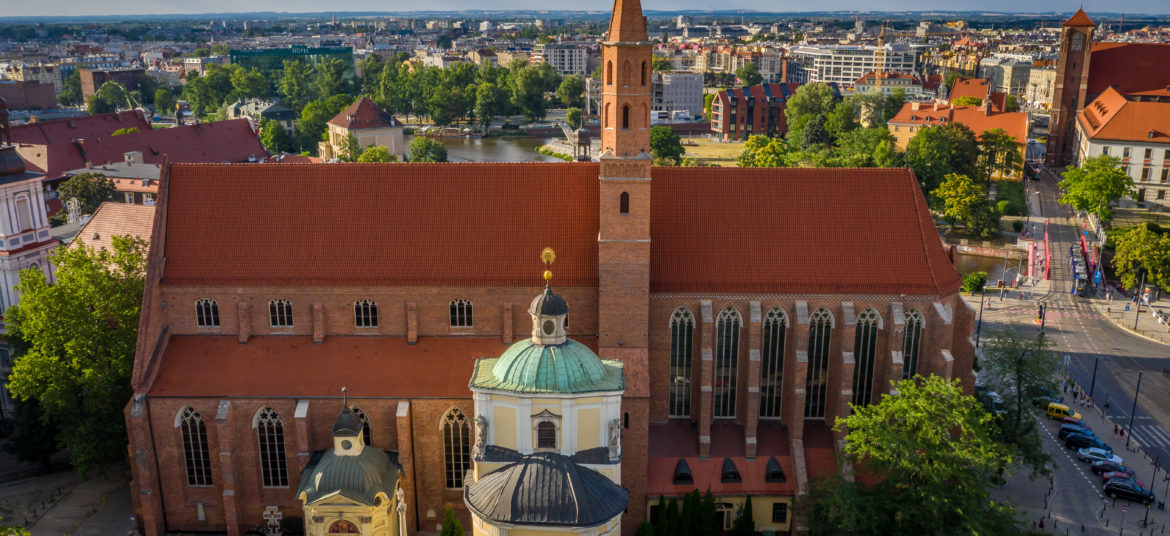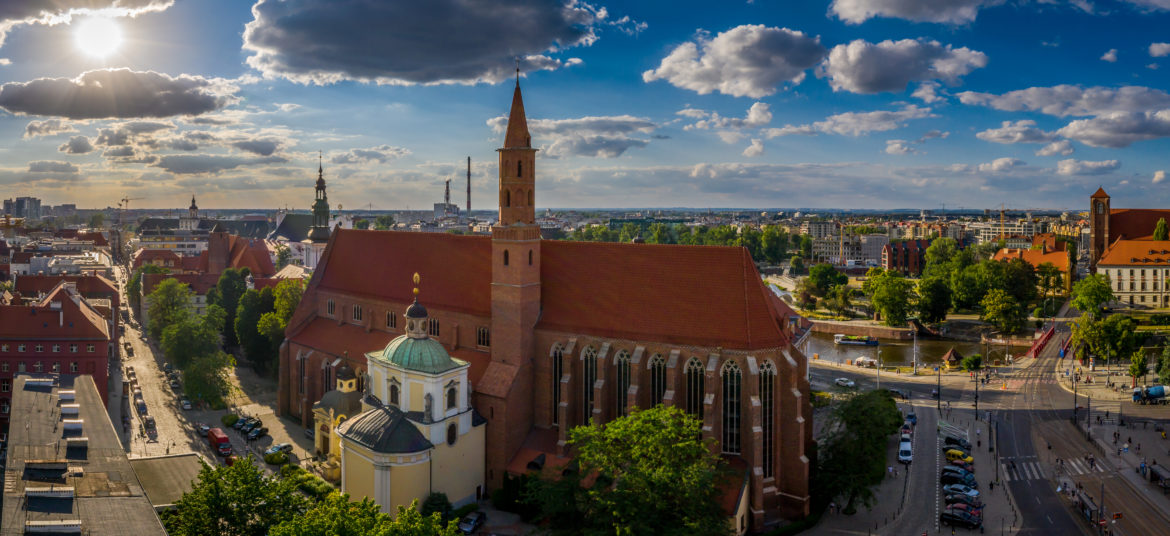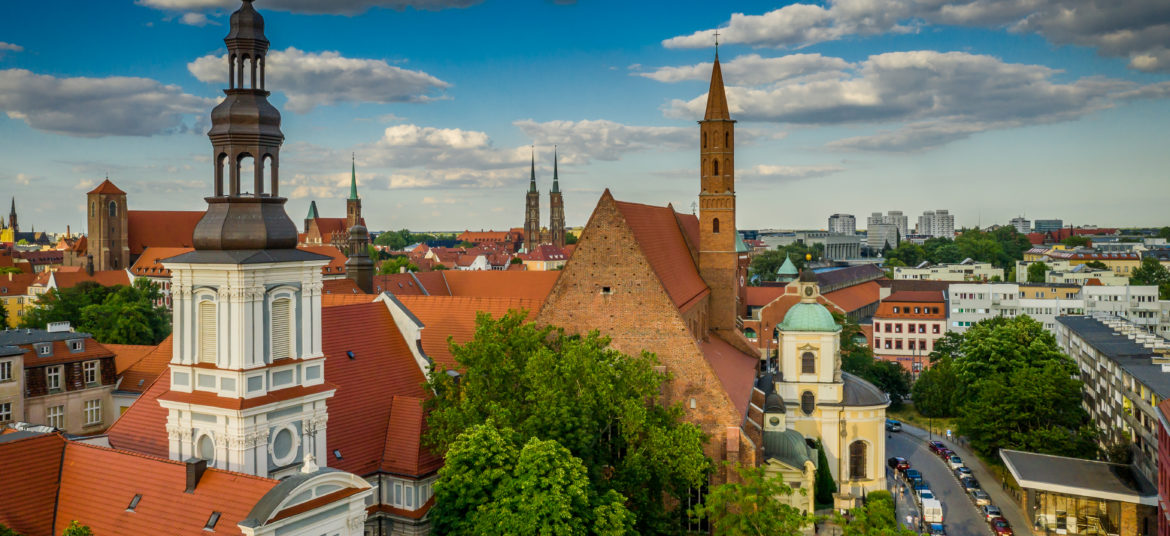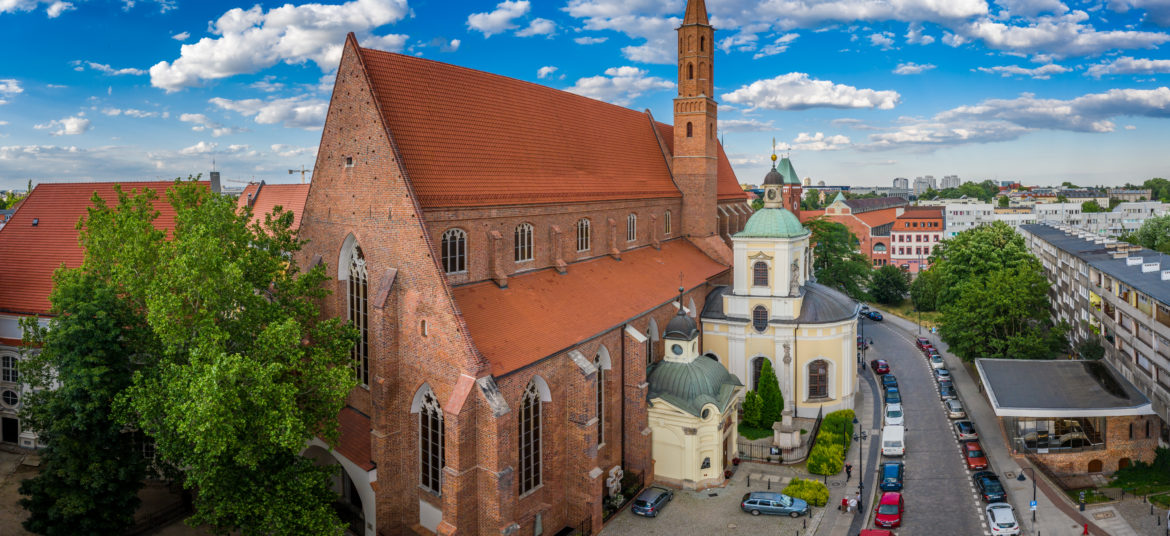Katedra
Cathedral Sobor of St Vincent and St James
of the Wrocław-Gdańsk Eparchy
of the Ukrainian Greek Catholic Church in Wroclaw
Greek Catholic Parish of the Exaltation of the Holy Cross
Parish priest:
Fr. Andrzej Michaliszyn
Parochial vicars:
Fr. Yevhen Sukhyy
Fr. Mateusz Demeniuk
Services in the Cathedral:
Divine Liturgy on Sundays: 8.00 a.m., 10.00 a.m., 5.00 p.m.
Matins on Sundays: 9.00 a.m.
Divine Liturgy on Feasts (weekday):
10.00 a.m., 6.00 p.m.
Weekday Divine Liturgy: 8.00 a.m. (or 4.00 p.m., according to parish announcements)
Address for correspondence:
ul. Łaciarska 34/6
50-146 Wrocław
tel.: +48 608 680 331
e-mail: a.michaliszyn@wp.pl
History Outline
The Cathedral Sobor of St Vincent and St James of the Wrocław-Gdańsk Eparchy of the Ukrainian Greek Catholic Church has a rich history.
When in 1226 Franciscans arrived to Wrocław from Prague, prince Henry the Pious funded for them the church and monastery of St James (present-day plac Biskupa Nankiera 15). After Henry’s death in the battle of Legnica, the widow, princess Anna, completed this work. The corpse of Prince. Henry the Pious was laid in the crypt of the presbytery in the temple he founded.
The church in the Romanesque style was a three-nave building, and its fragments from the twelfth century have been preserved in the walls of the temple to this day. The church of St James is bound by the date important for Wroclaw, 12 December 1261, when the location of this new town took place. This act was issued by the sons of Henry the Pious – Henry III and Władysław – in the presence of princess Anna and church dignitaries, and the ceremony took place in the Franciscan church.
The expansion of the church in its present shape began in the first half of the fourteenth century from the presbytery in which the Gothic sarcophagus of Prince Henry the Pious stood. The nave was constructed at the turn of the fourteenth and fifteenth centuries, when it was enlarged east and west, so that the length was 77.5 m. The church then, according to the record of Bartłomiej Stenus (1512) had 20 altars. The slender church tower was located on the south side, between the presbytery and the nave.
In 1339, when Bishop Nankier, a zealous defender of Poland’s rights to Silesia, cursed the Czech king John of Bohemia (it happened in the Franciscan monastery), the monks and the German city council voted against the bishop. After 1517, most monks converted to Protestantism and left the monastery. In 1529, few Franciscans who stayed Catholic were transferred to the deserted monastery of St Dorothy (present-day ul. Świdnicka), and thus the monastery and church (plac Biskupa Nankiera) were given to Premonstratensians from the Abbey of St Vincent in Ołbin (in vicinity of present-day ul. Nowowiejska and ul. B. Prusa). On 3 June 1530, Premonstratensians, also known as Norbertans, consecrated the church (pl. Nankiera), changing its title to St Vincent. During the Renaissance, the monastery of Premonstratensians became impoverished and the monks could not afford the renovation of the church. In 1585, abbot Jan VIII Cyrus gave various monastery valuables (candlesticks, gilded plates) in pledge. The financial situation of the monastery significantly improved only at the beginning of the seventeenth century, and then the interior of the church was renovated: new organs was built, as well as two chapels under the choir, three new altars were erected, the sarcophagus of Henry the Pious was renovated. In the years 1662–1674 the church received new, uniform baroque equipment. It included beautiful carved stalls from 1662–1665, a new main altar and tabernacle from 1667. This altar, the work of Franciszek Zeller, was decorated a year later by Jerzy Czerniak, who was paid 210 thalers for this
work. Czerniak was commissioned to paint the balustrade on the steps and bars in front of the presbytery. The new equipment also included figural sculptures by Franciszek Zeller, side altars, a pulpit from 1673, an organ screen. The church was also embellished with valuable paintings by Michael Willmann (including the Assumption of Mary, Crucified Christ, saints John the Baptist, Jadwiga, Stanisław) and from the Willman school. In 1699, the Premonstratensians erected a southern porch designed by Jan Jerzy Knoll, and next to it, on the order of abbot Bogusław Czeleszowski, a sandstone column was erected, with a statue of Mary, Mother of God.
In the years 1723–1727, on the southern side of the church, in place of the demolished old chapel, a chapel dedicated to Our Lady of Sorrows was erected, which turned out to be the most important construction work of Premonstratensians from the 18 th century. The design of the chapel, an outstanding architectural work of the late Baroque period, came from the hands of the city builder Krzysztof Hackner, and the sponsor was the abbot of the monastery, Ferdynand Hochberg. The chapel, built on a rectangular plan, received a rich decor. These were frescoes under the dome with scenes from the life of the Mother of God (1725), sculptures by Jan Jerzy Urbański, stone decorations from the workshop of Jan Adam Kharinger, a lattice considered a masterpiece of blacksmith’s art, and others. The fifteenth century Pieta was placed in the altar, while outside – statues of the Mother of God, St Barbara and St John of Nepomuk.
In 1746, the church received another 15 large paintings by Filip Bentum, depicting the life of St Vincent. After secularisation in 1810, the church began to serve as a parish church. The last pre-war priest was Paul Brosig, who died on 26 November 1944.
The destruction of the church and monastery building in 1945 was estimated at 75 percent. The tower was hit by a shell, and falling debris demolished the southern wall of the choir. Works of destruction were completed by a fire on 1 April: roofs burned down, all vaults collapsed. The list of losses also included most of the equipment and decor, including the interior of the chapel of Our Lady of Sorrows, where the walls were seriously damaged. The sarcophagus of Henry the Pious, previously hidden by German conservators in Wierzbin near Świdnica, and found after the war, is now in the National Museum in Wrocław. The surviving stalls were moved to the presbytery of the Wrocław cathedral of St John the Baptist in Ostrów Tumski. The reconstruction of the temple took place in stages and the final restoration continues to this day. A magnificent Gothic basilica (at present-day pl. Nankiera) was already from its creation one of the largest churches in Wrocław. The three-nave, five-span corpus and one-nave, six-span presbytery, ended on three sides, have a total length of 77.5 m. The interior height of the nave reached 23 m, and the presbytery is 33.25 m long and 8.6 m wide: the width of the three naves is 22 m, including the central nave 7.9 m. The interior is covered with quadripartite rib vault. The building, preserved until today in its basic shape, is built of brick, with only a little use of hewn stone. The slender tower was built on a square plan: above the gallery it transcends into a two-storey octagonal extension. The roof is traditionally covered with tiles. In 1997, the 46th International Eucharistic Congress took place in Wrocław and on this occasion the Holy Father John Paul II accepted the church of St Vincent as a gift from the Metropolitan Archbishop, Cardinal Henryk Gulbinowicz, and establishing this church as the Cathedral of the Diocese of the Wrocław-Gdańsk Greek Catholic Church, he passed it on to the faithful in the hands of the first Ruling Bishop, Teodor Majkowicz.
The Greek Catholic parish in Wrocław carried out the necessary renovation and adaptation works for the Eastern Rite in the years 1997–1999. The successful completion of this work was possible thanks to the great commitment and organisational skills of Mitred Archpriest, Fr. Piotr Kryk. parish priest and administrator of the Wrocław-Gdańsk Diocese.
In this temple, starting from 1 st May 1999, Divine Liturgies in Ukrainian are celebrated daily at 8:00 a.m. and on Sundays and Feast days at 10.00 a.m.
Based on the publication “Kościoły Wrocławia” by Zygmunt Antkowiak (Muzeum
Archidiecezjalne we Wrocławiu, 1991).
Written by: Iwan Andrunyk, Wira Bednarek, Zenon Salamon
Documents
Dear brothers in episcopal and priestly ministry!
Dear brothers in episcopal and priestly ministry!
Cardinal Henryk Gulbinowicz, Archbishop-Metropolitan of Wrocław, Host of the 46th International
Eucharistic Congress, concerned about the spiritual development of his Archdiocese and faithful of
the Greek Catholic (Byzantine-Ukrainian) Church of the Wrocław-Gdańsk Diocese, established on
24 May 1996, passes to my hands St Vincent’s Church (plac Nankiera 2) in Wrocław as a ‘Congress
Gift’.
Father Cardinal Henry, I gratefully accept this ‘Congress Gift’ of Your Archdiocese and give it to the Diocese of Wrocław-Gdańsk of the Greek Catholic (Byzantine-Ukrainian) Church, to the hands of its first Bishop Teodor. Today, I establish this church as the Cathedral of this new Diocese with the capital in Wrocław, in place of the former one, dedicated to Saint Bartholomew (the lower church of the Holy Cross on Ostrów Tumski).
May this new cathedral temple be a sign of exemplary cooperation of both Churches in this city.
May it be an ecumenical challenge for present and future generations, that in a spirit of faith. love
and hope, we must build a human community.
I bless the new Wrocław-Gdańsk Diocese and its first Bishop.
Wrocław, 1 June 1997.
Pope John Paul II
Your Excellency,
I’m enclosing a Document regarding the transfer by the Holy Father John Paul II of the
‘CONGRESS GIFT’ for the Wrocław-Gdańsk Diocese of the Greek Catholic Church.
With respect.
Józef Kowalczyk
Apostolic Nuncio
